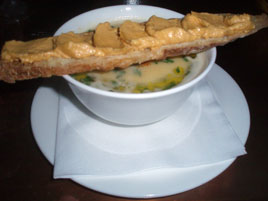Casa Nonna
 Tuesday, July 26, 2011 at 10:25AM
Tuesday, July 26, 2011 at 10:25AM  When investor Jimmy Haber and chef Laurent Tourondel broke up their BLT Restaurant Group last year, expansion strategy turned out to be the sticking point. Haber “wanted to develop new restaurants that were more affordable, appealed to a wider audience and did not carry the BLT name.” Tourondel did not want any other chef as an equal partner.
When investor Jimmy Haber and chef Laurent Tourondel broke up their BLT Restaurant Group last year, expansion strategy turned out to be the sticking point. Haber “wanted to develop new restaurants that were more affordable, appealed to a wider audience and did not carry the BLT name.” Tourondel did not want any other chef as an equal partner.
 Haber’s rustic Italian joint, Casa Nonna (“Grandmother’s House”), finally sent Tourondel packing. According to Crain’s, the Washington, D.C. restaurant threw off $70 million in annual revenues. You can see why Haber would expand in that direction, and why Tourondel would consider it a threat. [Correction: $70 million was the group revenue; see comment below.]
Haber’s rustic Italian joint, Casa Nonna (“Grandmother’s House”), finally sent Tourondel packing. According to Crain’s, the Washington, D.C. restaurant threw off $70 million in annual revenues. You can see why Haber would expand in that direction, and why Tourondel would consider it a threat. [Correction: $70 million was the group revenue; see comment below.]
In truth, even the group’s high-end BLT restaurants were gradually losing relevance: there were too many of them for Tourondel to do much more than lend his name to efforts that were increasingly derivative. Haber’s plan to focus on food for the masses was probably the more sensible one. He was headed in that direction anyway.
Tom Sietsema, restaurant critic for The Washington Post, gave Casa Nonna two stars out of four. I have no idea whether that’s justified. But in New York, where there are dozens of excellent rustic Italian restaurants, the bar is much higher.
The 200-seat Casa Nonna in far west midtown is handsomely decked out in a Corporate Italian way. When the 3rd Casa Nonna opens, heaven knows where, they’ll hand over the blueprints and source Italian knick-knacks from the same second-hand supplier that decorates the likes of Applebee’s.
 Chef Amy Brandwein’s menu is somewhat predictable and a shade on the expensive side. Antipasti are $6–13, primi $17–28, secondi $21–45 (but most in the $20s), contorni $6–10. These aren’t outrageous prices by midtown standards, but Casa Nonna is competing in a crowded field, and for the same money you can do better elsewhere.
Chef Amy Brandwein’s menu is somewhat predictable and a shade on the expensive side. Antipasti are $6–13, primi $17–28, secondi $21–45 (but most in the $20s), contorni $6–10. These aren’t outrageous prices by midtown standards, but Casa Nonna is competing in a crowded field, and for the same money you can do better elsewhere.


Whole Grilled Branzino ($26; above left) was very good, although plenty of New York restaurants offer the same item. Guance di Maiale, or braised pork cheeks ($23; above right) was the only item on the menu that seemed slightly unusual. The plating would win no awards, but the white wine tomato ragu and creamy polenta complemented the pork nicely.
Located on an uninteresting block near the garment district, west of Eighth Avenue, Casa Nonna isn’t an immediate hit. On a recent Wednesday evening, there was a decent crowd at the bar, but we had the dining room very nearly to ourselves. The site is a bit too far away from Broadway to be an obvious pre-theater place, and it isn’t interesting enough to be worth a detour.
Casa Nonna (310 W. 38th Street between Eighth and Ninth Avenues, West Midtown)
Food: *
Service: *
Ambiance: *
Overall: *




























